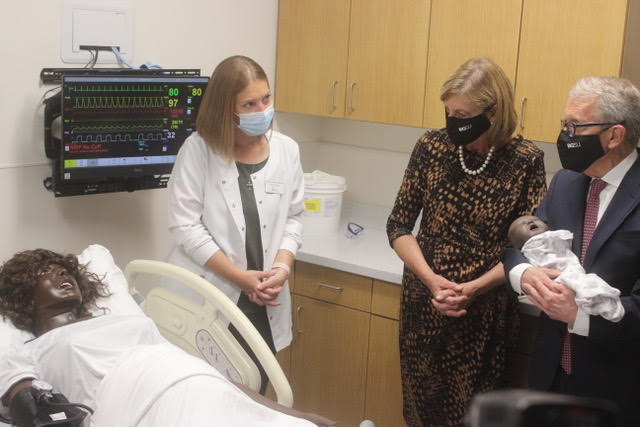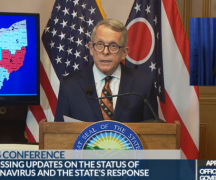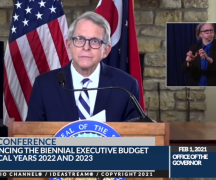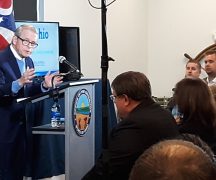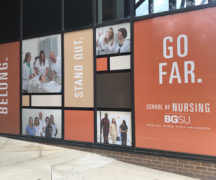By DAVID DUPONT
BG Independent News
Fran DeWine handed the baby to her husband, Gov. Mike DeWine, and fitting for a father of eight and grandfather of 26, he slipped into that easy swaying motion intended to keep the infant settled.
This baby wasn’t real.
It is high fidelity computerized mannequin in the new nursing lab at Bowling Green State University, and before the governor moved on it vocalized to demonstrate its realism.
This mannequin is an important tool to help train nurses to face are very real, life and death problems.
Lisa Jacobs, evidence based practice and simulation coordinator, noted that Ohio has problems with infant mortality.
The governor acknowledged that, and said addressing it was a priority.

Finding the nurses to provide the care is also a critical problem. That’s what BGSU’s new nursing program is meant to help solve.
DeWine along with his wife and Chancellor of Higher Education Randy Gardner visited campus Thursday to tour the new College of Nursing. Along the way they made a stop at the College of Technology to view the robotics and advanced manufacturing labs.
“We at Bowling Green we are very focused on relevant meaningful academic programs that are connected to our partners and industry,” BGSU President Rodney Rogers said in the press conference at the end of the visit.
“We have so many good things going for us in Northwest Ohio and across the state of Ohio,” DeWine said. “It’s really going to come down to people, skill sets of workers, to do the job. What we saw today gave us a great deal of confidence.”
He also heard about the need. DeWine asked members of the nursing faculty about what they were hearing from their colleagues in the field.
Jodi Speweik, an assistant teaching professor, said that she hears about shortages.
Annette Oberhaus, skills lab coordinator, told DeWine that they are discouraged
They expected to be treating people, but not with this level of acute disease. “They’re used to sending people home. But they’re not having those outcomes.”
Shelly Bussard, director of the school, said that the nursing shortage that was expected to hit in 2025, is already here. Hospitals are asking when she can send them nurses. All she can promise is in a year and a half.
The first group of 41 juniors are moving their way through the lab, some started at BGSU, others are transfers. The plan is to double that number. This year 127 first year students enrolled in the nursing program.
In the past students would spend their first two years at BGSU, and then hope to place into the program operated as a consortium with University of Toledo. That arrangement was ended, so both universities can increase the number of nurses they graduate.
Now nursing students will be able to stay at BGSU, or continue their studies with the university’s partnership with Mercy College.
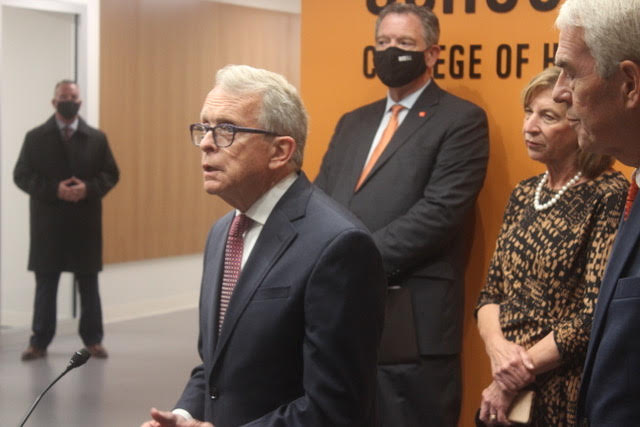
During the press conference, DeWine addressed the problem of infant mortality.
According to the CDC, in 2019 Ohio had 6.97 infant deaths per 1,000 births. That tied South Carolina for the ninth worst in the nation.
“We have a great racial disparity in the state of Ohio. An African-American baby is much more likely to die than a white baby,” he said. “That’s just not right, and it’s preventable also. One of the things I’ve asked the legislature to do and they’ve done it on two occasions and in two budgets is to put more money into outreach programs to reach pregnant mothers in difficult circumstances and particularly target those who are poor, those who have a drug addiction, those who for some reason that birth outcome may not be good. We know what will work are those outreach programs. We’re not there yet. We have a long way to go.”
If an expectant mother can get care early, or even later, in her pregnancy, that boosts the probability that the baby will be born healthy.
There’s also a problem of mothers dying as a result of giving birth. “We have a disparity again between African-American mothers and white mothers. In 2021 that should not exist.”
DeWine also reiterated his opposition to legislation that would limit the ability of institutions to require people to wear masks. “We have to allow flexibility to our hospitals, our state universities,” he said. “Our state universities are doing a very good job.”
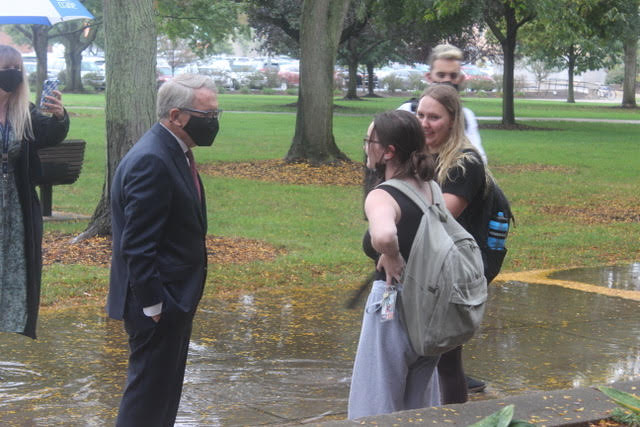
He also noted that the vaccination rates at state universities are higher than the statewide rates. However, he stopped short of endorsing vaccine mandates such as the one that will be in place at BGSU in the spring semester.
He demurred indicating they weren’t necessary.
Instead, DeWine said, the state should concentrate on trying to do everything it can to get people vaccinated.
The numbers show, he said, that 97 percent of those who have been hospitalized since January, have not been vaccinated. “These vaccines are powerful, amazing.”
Breakthrough cases in those who have been vaccinated, he said, are much milder.
The most recent deaths from COVID-19 are “a desperate tragedy” because “now every single death could have been prevented. What a horrible thing for that family to know.”
DeWine said he was optimistic that by the end of the year the federal government will have approved vaccine for those 5 years old and older. When that happens, DeWine said, “we’re going to really make sure that vaccine is available.”

